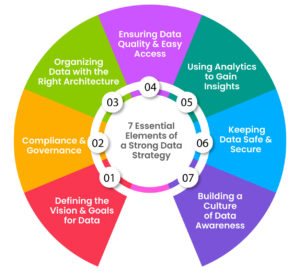Modern organizations are built on data, which drives revenue growth, enhances efficiency, and guides decision-making. However, to fully utilize data, businesses must have a clear data strategy. Data collection, storage, analysis, and protection that is in line with company objectives are guaranteed by a solid data strategy.
Organizations run the danger of data silos, security breaches, and lost opportunities when they don’t have an organized strategy. To assist businesses in fully using their data and maintaining an advantage in a ruthless market, we will explore the seven key elements of a data strategy in this blog post.
Let’s start!
Understanding Data Strategy
An organization’s plans for gathering, managing, governing, using, and extracting value from its data are outlined in a data strategy. Data democratization goals and data management strategy priorities are established, and it serves as a roadmap for coordinating data operations with more general business objectives.
Purpose of Data Strategy
As the company plan evolves, the data strategy must be flexible. You will need to change your approach to become data-driven and monetize data as a product if the business objective of your data operations is to boost efficiency, performance and income. However, both need data collection, maintenance, security, and analysis to be done on a single platform.
7 Essential Elements of a Strong Data Strategy
#1 Defining the Vision and Goals for Data
Well-defined objectives and a clear vision are the foundation of every successful data strategy. Companies must ask themselves: What are we hoping to accomplish with our data? Having a clear objective aid in directing data-related activities, whether the objective is to enhance customer satisfaction, boost income, or simplify processes. To monitor progress over time, it’s also critical to establish quantifiable goals.
Example:
A food delivery app aims to cut delivery times by 15%. To improve efficiency and customer satisfaction, they develop more intelligent delivery routes by analyzing historical orders, traffic patterns, and restaurant preparation times.
#2 Compliance and Governance
Data governance makes ensuring that information is handled correctly and in accordance with the law. It involves establishing precise guidelines for data protection, storage, and access. In addition to ensuring accuracy and preventing data leaks, strong governance also assists companies in adhering to laws like GDPR and HIPAA. Businesses that lack adequate governance run the danger of penalties, security lapses, or a decline in consumer confidence.
Example:
A hospital has stringent guidelines for accessing patient data. To maintain patient privacy and adherence to healthcare regulations, only physicians and nurses who are actively caring for the patient can access their information.
#3 Organizing Data with the Right Architecture
For storing, arranging, and integrating data across many systems, data architecture functions similarly to a blueprint. It is simpler to access, analyze, and exchange information when data is organized properly. It avoids the disarray and inefficiencies that might result from data being dispersed among many locations. Data organization is aided by automation technologies, data warehouses, and cloud storage.
Example:
A worldwide fashion firm uses the cloud to centralize its inventory and sales data. By doing this, managers in various places may view stock levels in real time and prevent popular things from running out.
#4 Ensuring Data Quality and Easy Access
Good data is current, accurate, and readily available. Incomplete or disorganized data may lead to incorrect choices. Companies need to routinely clean their data, eliminate duplication, and ensure that workers can easily locate the information they need. Teams can trust their findings when they have access to high-quality data.
Example:
An online travel agency fixes price mistakes and eliminates out-of-date hotel listings. Customers’ booking experiences are enhanced because of ensuring they only see accurate selections.
#5 Using Analytics to Gain Insights
Businesses may better analyze consumer behavior, forecast trends, and enhance operations with the use of advanced analytics. Businesses may use business intelligence (BI) and artificial intelligence (AI) solutions to transform unstructured data into insightful knowledge. To make better judgments for the future, firms may use data rather than only focusing on historical trends.
Example:
A fitness app makes recommendations for individualized training regimens based on an analysis of user exercises. The software helps users attain their fitness objectives and keeps them interested by analyzing their previous activity levels.
#6 Keeping Data Safe and Secure
Sensitive information is shielded by data security against hackers and illegal access. To avoid security breaches, businesses need to implement encryption, security software, and strong passwords. Employee training and routine security audits both contribute to risk reduction. Customers trust businesses that protect their data, therefore robust security measures are crucial.
Example:
An online bank protects customer accounts by preventing suspicious transactions before they occur through the use of AI fraud detection and multi-factor authentication.
#7 Building a Culture of Data Awareness
When a company has a strong data-driven culture, all levels of workers know how to use data in their everyday jobs. Improving decision-making may be achieved through training, user-friendly dashboards, and fostering interest in data. When workers are comfortable utilizing data, companies become more inventive and efficient.
Example:
A retail chain teaches shop managers how to evaluate sales data. By identifying purchasing patterns, they may modify inventory levels to satisfy consumer demand, cutting waste and boosting revenue.
Accessing Business Potential with Data!
The secret to maximizing the value of data, guaranteeing security, and making well-informed business decisions is a well-thought-out data strategy. Organizations may stay ahead in today’s digital era by setting clear goals, making sure that compliance is followed, efficiently organizing and preserving data, using analytics, giving security priority, and cultivating a data-driven culture.
Investing in these seven vital elements will boost innovation and development in addition to improving efficiency. It is more important than ever to have a strong data strategy in place since organizations are still producing enormous volumes of data.
Take the first step towards a smooth and successful data strategy and begin creating a more intelligent, data-driven future for your company right now!
To get more knowledge-driven and data-oriented content, keep reading our blog posts at HiTechNectar.
FAQs
Q1. What are the pillars of data strategy?
Answer: The foundations of developing a data strategy should be established at an early stage. These six pillars—your vision and values, people and culture, operational models, data governance, technology and architecture, and your roadmap—form the foundation of your data strategy.
Q2. What is a data strategy roadmap?
Answer: The implementation method for how an organization will efficiently manage, analyze, and use data to accomplish its business objectives is described in a data strategy roadmap.
You May Also Like To Read:
Data Deduplication benefits and Use Cases in Business
Top 7 Open-Source Master Data Management Tools



